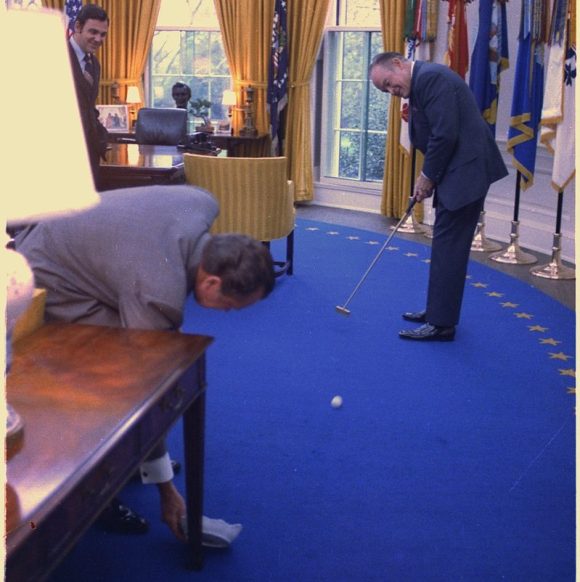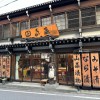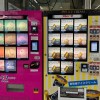
Japan may be the only country in the world that insures golfers in the event they hit a hole-in-one during a round of golf.
■ A Cinderella story outta nowhere
They say the odds of hitting a hole-in-one in golf are around 12,000 to 1 which is somewhere around the probability of finding a pearl in an oyster. And if your unlikely shot happens in Japan, you may be wishing for that pearl. That’s because upon sinking one, the player is morally obligated to hold and pay for a party in their own honor comparable to a mini-wedding.
We’re talking food, drinks, entertainment, and even souvenirs for all the guests, commemorating this special moment in casual sports. Depending on your financial situation, this may turn out to be a huge burden on your bank account. Luckily, insurance companies are here to help.
■ Hole-in-one insurance
Something known as “hole-in-one insurance” exists in a lot of countries as a type of prize indemnity insurance that covers tournament organizers.
Let’s say you want to hold a golf tournament and, as a special draw for participants, you offer a Lamborghini as a bonus prize for anyone who hits a hole-in-one. As we already saw, with the odds of hitting such a shot, it’s a reasonable risk for a sexy promotion…but you never know.
So, instead the organizers will buy some insurance at a much lower cost to cover the price of a high performance sports car in the rare chance that it’s needed.
In Japan, however, hole-in-one insurance is quite the opposite thing. Let’s take a look at an example of such a policy from a major company MS&AD Insurance Group.

In a nutshell it says that as long as you hit a hole-in-one or albatross (hole-in-two on a par-five hole) on Japanese soil with a witness, then you are eligible for coverage. The minimum witness is an employee of the golf course, most likely a caddy, but a combination of fellow players and other unrelated players waiting for their turn are acceptable.
Coverage includes the cost of the party, commemorative souvenirs for the guests, a commemorative tree planting on the course, a tip for the caddy (who just happens to be a key witness), and a philanthropic donation to the golf course itself up to a certain amount. Depending on the package, coverage can extend to one million yen (US$9,400)
■ Gentleman’s game
After reading that, if you’re cripplingly cynical like myself, you’re probably wondering what’s to stop people from defrauding hole-in-one insurance left right and center.
I asked that of an acquaintance who has golfed on some of the finest courses in Japan and abroad and who has heard a few tales of hole-in-one parties. He said, “Golf is generally considered a gentleman’s game. It’s not in the character of the players to do such a thing. Besides, if they got caught it would ruin their reputation.”
▼ Gentlemen Richard Nixon and Bob Hope taking a moment for some ashtray golf in the oval office

I then asked a friend who is an executive for an insurance company the same thing. She told me, “Of course, it’s easy to defraud. To investigate we can only interview witnesses, but even if someone says a hole-in-one wasn’t made, that’s not enough evidence to prove a fraudulent claim.”
This begs the question: Why are insurance companies in their right mind allowing such freewheeling coverage? The answer to that likely lies in the history of the custom.
■ Capitalism at its purest
Reading around about hole-in-one parties, the common reason given is that in Asian culture, when a great stroke of luck occurs, one ought to pay it forward as much as possible to avoid any misfortune down the road. While that may be true for Asian culture, it doesn’t really explain why only Japan has this particular ritual.
The Kyoei Fire and Marine Insurance company claims to have been the first to offer hole-in-one insurance back in 1982. At that time golf courses were luxuries only for the highly wealthy in a country with very limited space. It was also around this time that the Japanese economy was seeing a great deal of growth.
So it would seem likely that, around this time, some golfers with massive bank accounts and egos to match began this extravagant tradition. And insurance companies keenly saw an opportunity to woo them. It was kind of brilliant in that only people who could make use of hole-in-one insurance were pretty much guaranteed to require extensive coverage in general.
Fraudulent or not, giving away a free party is a small price to pay when it means a client is guaranteed to have loads of property to insure. Meanwhile, a caddy gets a nice payday, a golf course ends up with a nice chunk of change, and, most importantly, the client gets to soak in the honor of hitting a ball into a tiny hole from really far away. Everyone’s a winner!
However, those days led to an economic bubble which burst long ago. Also, golfing in Japan has become much more affordable in recent years and it’s not just a pastime of the elite. It will be interesting to see if hole-in-one parties and their insurance can continue much longer.
In the meantime though, if you happen to be in Japan and pull off a hole-in-one, you might want to keep it to yourself.
Source: MS&AD Insurance Group, The Kyoei Fire and Marine Insurance Company, Golfista (Japanese), Sheknows (English)
Top Image: Wikipedia/Angel Aroca Escámez

 Inside China’s Mission Hills Golf Club, the largest golf resort in the world
Inside China’s Mission Hills Golf Club, the largest golf resort in the world If you have an apartment in Japan, your “fire disaster insurance” may also be toilet insurance
If you have an apartment in Japan, your “fire disaster insurance” may also be toilet insurance Sompo Japan offers nation’s first online flaming insurance
Sompo Japan offers nation’s first online flaming insurance This Mario golf bag might not lower your score, but it will definitely give you 1-up
This Mario golf bag might not lower your score, but it will definitely give you 1-up You can now buy bully insurance for your kids in Japan
You can now buy bully insurance for your kids in Japan Godzilla leather wallet will make you feel like the King of the Monsters and lord of fashion
Godzilla leather wallet will make you feel like the King of the Monsters and lord of fashion This is Japan’s, and the world’s, first capsule hotel, and you can still stay there
This is Japan’s, and the world’s, first capsule hotel, and you can still stay there How to make a secret rice bowl at Ichiran ramen
How to make a secret rice bowl at Ichiran ramen Tokyo sweets store sells beautiful soft serve ice creams that look like works of art
Tokyo sweets store sells beautiful soft serve ice creams that look like works of art Cheap Japanese ryokan at Kusatsu Onsen is hidden at the back of a traditional store
Cheap Japanese ryokan at Kusatsu Onsen is hidden at the back of a traditional store Japan has nearly 4 million abandoned homes, but where and why?
Japan has nearly 4 million abandoned homes, but where and why? Kumamoto Governor embroiled in flower scandal
Kumamoto Governor embroiled in flower scandal Shinkansen station platforms now have…Baskin Robbins ice cream vending machines!
Shinkansen station platforms now have…Baskin Robbins ice cream vending machines! Kyoto government worker assaults coworker for spoiling popular manga series at the office
Kyoto government worker assaults coworker for spoiling popular manga series at the office Japanese cosplayer creates amazing outfit: Sailor Moon’s transformation sequence!【Photos】
Japanese cosplayer creates amazing outfit: Sailor Moon’s transformation sequence!【Photos】 McDonald’s Japan’s new pancake pie is a taste sensation
McDonald’s Japan’s new pancake pie is a taste sensation Bad tourist manners at Mt Fuji Lawson photo spot prompts Japanese town to block view with screens
Bad tourist manners at Mt Fuji Lawson photo spot prompts Japanese town to block view with screens Foreigner’s request for help in Tokyo makes us sad for the state of society
Foreigner’s request for help in Tokyo makes us sad for the state of society FUK COFFEE?!? Japanese cafe has a perfectly innocent reason for its startling-looking name
FUK COFFEE?!? Japanese cafe has a perfectly innocent reason for its startling-looking name One of Japan’s oldest castles now lets travelers spend night on the grounds, drink in its keep
One of Japan’s oldest castles now lets travelers spend night on the grounds, drink in its keep Two things to do, and two things not to do, when leaving a traditional Japanese inn
Two things to do, and two things not to do, when leaving a traditional Japanese inn Studio Ghibli unveils new goods that tip the hat to The Cat Returns
Studio Ghibli unveils new goods that tip the hat to The Cat Returns Studio Ghibli unveils massive T-shirt collection featuring top anime movie characters
Studio Ghibli unveils massive T-shirt collection featuring top anime movie characters McDonald’s new Happy Meals offer up cute and practical Sanrio lifestyle goods
McDonald’s new Happy Meals offer up cute and practical Sanrio lifestyle goods Our Japanese reporter visits Costco in the U.S., finds super American and very Japanese things
Our Japanese reporter visits Costco in the U.S., finds super American and very Japanese things Japanese ramen restaurants under pressure from new yen banknotes
Japanese ramen restaurants under pressure from new yen banknotes All-you-can-drink Starbucks and amazing views part of Tokyo’s new 170 meter-high sky lounge
All-you-can-drink Starbucks and amazing views part of Tokyo’s new 170 meter-high sky lounge More foreign tourists than ever before in history visited Japan last month
More foreign tourists than ever before in history visited Japan last month New definition of “Japanese whiskey” goes into effect to prevent fakes from fooling overseas buyers
New definition of “Japanese whiskey” goes into effect to prevent fakes from fooling overseas buyers Disney princesses get official manga makeovers for Manga Princess Cafe opening in Tokyo
Disney princesses get official manga makeovers for Manga Princess Cafe opening in Tokyo Sales of Japan’s most convenient train ticket/shopping payment cards suspended indefinitely
Sales of Japan’s most convenient train ticket/shopping payment cards suspended indefinitely Sold-out Studio Ghibli desktop humidifiers are back so Totoro can help you through the dry season
Sold-out Studio Ghibli desktop humidifiers are back so Totoro can help you through the dry season Japanese government to make first change to romanization spelling rules since the 1950s
Japanese government to make first change to romanization spelling rules since the 1950s Ghibli founders Toshio Suzuki and Hayao Miyazaki contribute to Japanese whisky Totoro label design
Ghibli founders Toshio Suzuki and Hayao Miyazaki contribute to Japanese whisky Totoro label design Doraemon found buried at sea as scene from 1993 anime becomes real life【Photos】
Doraemon found buried at sea as scene from 1993 anime becomes real life【Photos】 Tokyo’s most famous Starbucks is closed
Tokyo’s most famous Starbucks is closed One Piece characters’ nationalities revealed, but fans have mixed opinions
One Piece characters’ nationalities revealed, but fans have mixed opinions We asked a Uniqlo employee what four things we should buy and their suggestions didn’t disappoint
We asked a Uniqlo employee what four things we should buy and their suggestions didn’t disappoint Japanese company offers insurance plan to protect against false train groping accusations
Japanese company offers insurance plan to protect against false train groping accusations Daihatsu dealership takes down controversial tweet boasting that they like trees
Daihatsu dealership takes down controversial tweet boasting that they like trees Nissan develops golf ball that automatically finds the hole every time
Nissan develops golf ball that automatically finds the hole every time “Bully insurance” now on the rise, with many more practical uses than just insuring bullying
“Bully insurance” now on the rise, with many more practical uses than just insuring bullying Fear and murder plague Western Japan golf courses over a checkbox on application forms
Fear and murder plague Western Japan golf courses over a checkbox on application forms Remember your manners or these hip-hop cleaning ladies will bust your ass
Remember your manners or these hip-hop cleaning ladies will bust your ass Bull suddenly rams into a sedan at railroad crossing in China, captured on video
Bull suddenly rams into a sedan at railroad crossing in China, captured on video Japanese grandpa swings golf club so hard it sets field alight, onlookers yell “fire” not “fore”
Japanese grandpa swings golf club so hard it sets field alight, onlookers yell “fire” not “fore” Japan’s amazing healthcare system summed up in photo of hospital bill for father’s heart surgery
Japan’s amazing healthcare system summed up in photo of hospital bill for father’s heart surgery Our Japanese reporter heads to Okinawa and a U.S. military casino to try and win it big
Our Japanese reporter heads to Okinawa and a U.S. military casino to try and win it big Shinkansen driver disciplined for taking poop break while train was going 150 kilometers an hour
Shinkansen driver disciplined for taking poop break while train was going 150 kilometers an hour Four foreign men arrested near Tokyo under charges of “international romance fraud”
Four foreign men arrested near Tokyo under charges of “international romance fraud” Japanese female pro wrestler uses “deadly weapon” to subdue opponent: a thick marriage magazine
Japanese female pro wrestler uses “deadly weapon” to subdue opponent: a thick marriage magazine President Trump’s Pearl Harbor comments turn out to be misreported, all of Japan sighs in relief
President Trump’s Pearl Harbor comments turn out to be misreported, all of Japan sighs in relief U.S. may demand compensation from Japan for having the nerve to snow on its planes
U.S. may demand compensation from Japan for having the nerve to snow on its planes
Leave a Reply